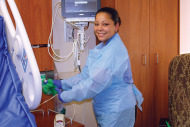When the Association for the Health Care Environment (AHE) launched its Certified Health Care Environmental Services Technician (CHEST) program in 2015, it set out to accomplish four goals:
- Highlight the important and life-saving work that technicians do every day.
- Reduce variation in practice through evidence-based protocols.
- Achieve a consistent standard of care.
- Establish and recognize technicians as a critical part of the patient care team.
According to results of a four-month study conducted this year by the American Hospital Association on facilities that implemented CHEST training, AHE has made progress in all four areas.
For instance, respondents noted a decrease in several infection rates after training was implemented, including a 3% decrease in Clostridium difficile rates. It also helped improve HCAHPS scores, as the average number of patients at the facilities surveyed who reported their bathroom was “always” clean jumped from 69% to 79%.
Reducing turnover has been another hallmark of the program. Respondents reported an average decrease of 7% in turnover rates after CHEST training.
Jessica Rivera, T-CHEST, director of environmental services (EVS) at University of Utah Health in Salt Lake City, became a designated trainer of the program in June 2016 and says that she immediately saw its benefits.
“When [AHE] created this program, I knew we had to jump on the bandwagon and go after it,” she says.
After receiving their trainer designations, Rivera and another supervisor, Oak Leavitt, began training front-line staff the next month. At the time, Rivera was an EVS manager leading three facilities and about 30 employees. As the health system began moving away from outsourcing at other facilities, Rivera’s responsibilities grew. Today, she manages 21 clinics and 74 employees. A new ambulatory facility under construction will add another location and 13 new full-time employees to her roster.
With facilities under her helm that cover nearly 4,000 square miles in distance, Rivera says the CHEST program has helped her department achieve consistent results. A recent audit by the system’s infection control department showed consistency in process across all of the facilities she oversees.
As of October, all but 20 technicians on her team had received their CHEST designation. With more classes planned for newer employees, Rivera’s goal is to have 100% of employees complete the program. AHE says that more than 3,900 technicians across the nation have been trained in the program’s evidence-based protocols and have received CHEST certification.
Rivera notes that her staff feels more empowered to approach clinical staff about environment of care matters, which tracks with results of the study.
According to respondents, daily interactions with nurses increased from 79% to 94%, and weekly interactions with infection preventionists increased from 18% to 45%.
“The return on investment is high because employees are prouder of the work they do,” Rivera says.





